Quiz Answer Key and Fun Facts
1. Hungary is a landlocked country in the heart of Europe. Which of these countries does it NOT share a border with?
2. The patron saint of Hungary was also the country's first king, whose crown is depicted on the Hungarian coat of arms. What was the name of this saint - whose feast is not celebrated on the day after Christmas?
3. The Great Hungarian Plain, or Alföld, includes the "puszta", one of the most recognizable features of the Hungarian natural landscape. What kind of biome, generally associated with Central Asia, is it?
4. A number of dog breeds have their origins in Hungary. What is the name of the sheepdog in the photo, characterized by the distinctive "dreadlocks" of its white coat?
5. Many Hungarian men bear the name of which fearsome conqueror, who is a revered figure in the country in spite of his bad reputation?
6. Though not exactly the best choice for anyone watching their weight, Hungarian cuisine is deservedly famous. A favourite among the many delectable Hungarian baked goods is "rétes", a rolled pastry filled with fruit, nuts, or cheese - better known by what German name?
7. In 2002, Imre Kertész became the first Hungarian writer to be awarded a Nobel Prize in Literature. What is the main topic of Kertész's work - shared by other eminent writers such as Elie Wiesel and Primo Levi?
8. Hungarian is one of the few European languages that does not belong to the large Indo-European family. Which of these English words is of Hungarian origin?
9. Like many other European cities, Budapest, Hungary's stunningly beautiful capital, was originally a Roman town. What was its name - a reference to the thermal springs that still abound in its territory?
10. This quiz's title is a homage to one of Hungary's most celebrated native sons - Franz Liszt, composer and pianist extraordinaire. Which of these famous Hungarians was also a composer, one of the 20th-century's most influential?
Source: Author
LadyNym
This quiz was reviewed by FunTrivia editor
agony before going online.
Any errors found in FunTrivia content are routinely corrected through our feedback system.
